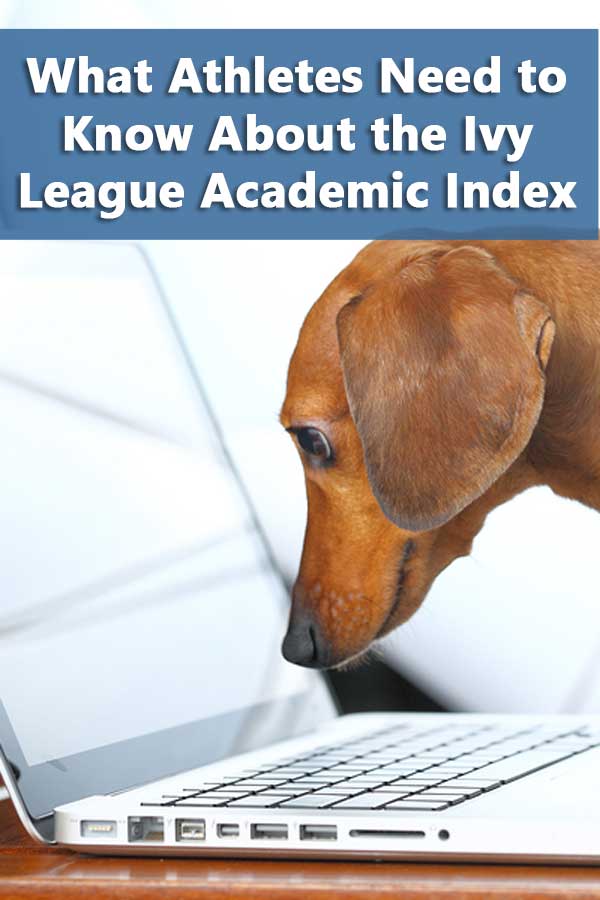 If you’re interested in playing your sport for one of the Ivy League schools, you need to understand the Academic Index. I’m assuming that you already know that the Ivy League does not provide athletic scholarships and that you’re hoping to use your athletic abilities to help you get admitted. After all, recruited athletes have approximately a 30 percentage point advantage in being admitted compared to non-athletes with no legacy status. And a recent analysis of data from Harvard showed that “Athletes with the highest or second-highest academic rating on an internal Harvard admissions scale have an acceptance rate of 83 percent—compared to 16 percent for non-athletes.”
If you’re interested in playing your sport for one of the Ivy League schools, you need to understand the Academic Index. I’m assuming that you already know that the Ivy League does not provide athletic scholarships and that you’re hoping to use your athletic abilities to help you get admitted. After all, recruited athletes have approximately a 30 percentage point advantage in being admitted compared to non-athletes with no legacy status. And a recent analysis of data from Harvard showed that “Athletes with the highest or second-highest academic rating on an internal Harvard admissions scale have an acceptance rate of 83 percent—compared to 16 percent for non-athletes.”
Join other parents in the College Recruiting Parent Zone
The Academic Index (AI) is used by Ivy League schools to ensure that athletes are not admitted with significantly lower academic qualifications than the general student population. The index is based on GPA, SAT/ACT tests scores, and SAT Subject test scores. All athletes must have at least a 176 to play at any of the “Ancient Eight” schools.
The following resources will get you up to speed about the Ivy League Academic Index.
Tier One Athletics: Academic Index
If you only visit one website to learn about the AI, this is the website. It includes nine articles on the Ivy League Academic Index and an AI calculator that is updated annually. It explains how the AI is calculated and how to interpret your AI. According to the website:
You could potentially go through the entire Ivy League recruiting process and never hear a coach mention the Academic Index. But from the coach’s perspective, it’s a make-or-break number. It’s a little like an academic credit rating – three different coaches could calculate yours and everyone would end up with slightly different numbers.
Athletic Recruiting at the Ivy League
If you’re looking for a quick but thorough summary of the Academic Index, this Varsity Edge post is based on an interview with the former Executive Director of the Council of Ivy Group Presidents. If there is some give academically, it’s in football. Otherwise:
The quality of these recruited student-athletes is also regulated: The mean AI of all of each year’s athletes at any school can’t deviate more than a set amount from the mean AI for the school’s overall student body. In layman’s terms, you need to be pretty close academically to the majority of students that attend the university.
Calculating Your Ivy League Eligibility
This is a short read from a test prep service and focuses pretty much on how the Academic Index is calculated. It tells you how it’s calculated along with an example. I think the concluding 5 things about what the AI means is worth the quick read.
5. Ivy admissions are tough, even for recruited athletes. All Ivy League schools start with a pool of more than a thousand players, and then whittle that pool down to 30. A typical “low-low,” therefore, will be in the top quarter of his high school class, with a 27 on the ACT (1220 SAT), and will be a first-team all-stater or even a high school All-American caliber player. A typical “high” might still be an all-conference caliber player with a 33+ ACT (1460+ SAT) and a top 5% ranking.
How Do Ivy League Schools Recruit? ACT/SAT Scores for Athletes
PrepScholar provides probably the most comprehensive overview of Ivy League recruiting, tests scores, and the academic index. It explains the differences between Ivy League recruiting and “regular” recruiting and even lists 50th% test scores and how to use them.
The article actually spends very little time on the Academic Index. The reason is simple as the article states that “You can look for Academic Index calculators online, but know that most are pretty inaccurate and won’t really help you figure out whether you’re on track to getting into the Ivy League as a student-athlete or not.” In other words, all of the other factors the article covers are probably more important.
The Ivy League’s Secret “Academic Index” for Recruiting
A quick overview of the Academic Index from the soccer perspective. Like some other articles, it provides some general band definitions. It emphasizes that
If you are a competitive soccer player with Ivy League goals, the best way you can help out an Ivy League coach is to have an AI that is at or above the average AI of non-athletes who get into the university.
Before Recruiting in Ivy League, Applying Some Math
This is probably one of the most referred to articles on the Ivy League Academic Index for recruiting. It was published by the New York Times in December of 2011 and received a lot of attention. The reporter, Bill Pennington, explains some of the overlooked nuances of how the AI works. He also points out that
The overall athletic A.I. can also be balanced by recruits with considerably higher A.I.’s who play other, lower-profile sports, or by recruits with exceedingly high A.I.’s who are stacked at the top end of a team’s roster.
The Rise of Harvard Basketball
This in-depth article by the Harvard Crimson gives you a feel for the pressures on athletic recruiting in the Ivy League, including the AI. For many coaches, the lack of athletic scholarships is a bigger hurdle than the AI:
“I think the biggest hurdle still is financial” said Donahue of the Ivy League’s lack of athletic scholarships. “It’s way more difficult to find kids that can afford this education and turn down scholarships than it is to find kids that are academically qualified. There are a lot of kids that are academically qualified.”
Getting in: Athletes’ Road to Admission
This is an article by the Daily Princetonian on athletic admissions. It doesn’t focus just on the AI but does explain why one team in particular at an Ivy may be doing better than others at recruiting:
the average Academic Index score for recruited athletes falls within one standard of deviation of the student body’s mean – is applied at the University level, rather than for each team. This is particularly important for sports with recruiting classes that can be as small as a few students per year. For example, if two golf recruits are slightly below the overall athletic program’s target for a given year, this can be offset by recruiting academic stars in tennis.
CONNECT WITH OTHER PARENTS WITH PROSPECTIVE COLLEGE ATHLETES
JOIN THE COLLEGE RECRUITING PARENT ZONE



3 thoughts on “What Athletes Need to Know About the Ivy League Academic Index”